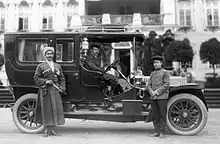Tsarskoye Selo
Tsarskoye Selo (Russian: Ца́рское Село́, IPA: [ˈtsarskəɪ sʲɪˈlo] (![]() listen), "Tsar's Village") was the town containing a former Russian residence of the imperial family and visiting nobility, located 24 kilometers (15 mi) south from the center of Saint Petersburg.[1] The residence now forms part of the town of Pushkin. Tsarskoye Selo forms one of the World Heritage site Saint Petersburg and Related Groups of Monuments.
listen), "Tsar's Village") was the town containing a former Russian residence of the imperial family and visiting nobility, located 24 kilometers (15 mi) south from the center of Saint Petersburg.[1] The residence now forms part of the town of Pushkin. Tsarskoye Selo forms one of the World Heritage site Saint Petersburg and Related Groups of Monuments.

The town bore the name Tsarskoe Selo until 1918, Detskoe Selo (Russian: Детское Село, lit. 'Children's Village', 1918–1937), then Pushkin (Russian: Пушкин, 1937 onwards).
History

The area of Tsarskoye Selo, once part of Swedish Ingria, first became a Russian royal/imperial residence in the early 18th century as an estate of the Empress-consort Catherine (later Empress-regnant as Catherine I (r. 1725–1727), from whom the Catherine Palace takes its name.
The Alexander Palace (built from 1792 onwards) originated as the home of the Grand Duke Alexander Pavlovich, who later became Emperor Alexander I (r. 1801–1825).
The Royal Forestry School, perhaps the first such school in Russia, was founded in Tsarskoye Selo in 1803; it was moved to Saint Petersburg in 1811, to become the Imperial Forestry Institute.[2]
Nickname for elite Soviet neighborhoods
In the Soviet Union the nickname "the Czar's village" came to apply to blocks and small neighborhoods that housed the nomenklatura (Soviet elites). Their stores were better stocked, although they were still affected by Soviet-era shortages. The buildings in the neighborhoods were better designed, constructed and maintained.[3] One such neighborhood, west of Moscow, contained less industry and more parks than any other neighborhood.[4]
.jpg.webp)
Monuments
- Alexander Palace and associated park
- Catherine Palace and associated park
- Sophia Cathedral
- Tsarskoye Selo Lyceum
Gallery
 Grotto pavilion in Catherine park of Tsarskoe Selo, Saint Petersburg, Russia
Grotto pavilion in Catherine park of Tsarskoe Selo, Saint Petersburg, Russia.jpg.webp) Catherine Palace with a view of the Cameron Gallery; Tsarskoye Selo in a watercolor by Luigi Premazzi, c. 1855
Catherine Palace with a view of the Cameron Gallery; Tsarskoye Selo in a watercolor by Luigi Premazzi, c. 1855 The Catherine Palace, the Great Hall
The Catherine Palace, the Great Hall Fire in the Catherine Palace 1942
Fire in the Catherine Palace 1942 Cameron Gallery Catherine Palace
Cameron Gallery Catherine Palace Jubilee Exhibition for the 200th anniversary of Tsarskoye Selo 1911
Jubilee Exhibition for the 200th anniversary of Tsarskoye Selo 1911 Catherine Palace at the main entrance, September 9, 1911. Adolphe Kégresse seated behind the wheel of the Imperial "Benz"
Catherine Palace at the main entrance, September 9, 1911. Adolphe Kégresse seated behind the wheel of the Imperial "Benz" Catherine Park, Pavilion "Grotto" 1910
Catherine Park, Pavilion "Grotto" 1910 Catherine Park, Pyramid 1910
Catherine Park, Pyramid 1910.jpg.webp) Catherine Park, Palladian Bridge
Catherine Park, Palladian Bridge Alexander Palace 1918
Alexander Palace 1918 Kegresse track outside Alexander Palace, January 1917
Kegresse track outside Alexander Palace, January 1917 "Chapel" in Alexander Park. 1897
"Chapel" in Alexander Park. 1897 Large Chinese Bridge in Alexander Park 1910
Large Chinese Bridge in Alexander Park 1910 "Grand Caprice" in Alexander Park 1911
"Grand Caprice" in Alexander Park 1911 Farm outbuilding with a tower in Alexander Park. 1910
Farm outbuilding with a tower in Alexander Park. 1910 Tsarskoye Selo Imperial Station/ Emperor railway station in Pushkin town 1910s
Tsarskoye Selo Imperial Station/ Emperor railway station in Pushkin town 1910s
References
- Jabado, Salwa; Fodor's (2008). Fodor's Moscow and St. Petersburg. New York: Random House. p. 292. ISBN 978-1-4000-0717-2.
- St. Petersburg Encyclopedia. Accessed: May 6, 2012.
-
Compare:
Gessen, Masha (2017). The Future is History: How Totalitarianism Reclaimed Russia. Granta Books. ISBN 9781783784011. Retrieved October 22, 2020.
Under the Soviets [...] the name 'the Czars' Village' began attaching itself to blocks and small neighborhoods that housed the Soviet elites.
The stores here were better stocked, even though they were affected by the shortages. The buildings were better designed and constructed. - Masha Gessen, (2017). The Future Is History: How Totalitarianism Reclaimed Russia.
Further reading
- King, Greg (2006). The Court of the Last Tsar (hardback). Hoboken: John Wiley & Sons. ISBN 978-0-471-72763-7.
External links
| Wikimedia Commons has media related to Tsarskoe Selo. |
| Wikisource has the text of the 1911 Encyclopædia Britannica article Tsarskoye Selo. |
- Tsarskoye Selo, Pushkin town, historical facts of the city, map, local weather, directions from St. Petersburg
- The State Museum of Tsarskoye Selo
- Alexander Palace Time Machine The Alexander Palace Time Machine
- Tsarskoye Selo in 1910 – a guide to the Palaces, Park and Town
- Photo Tours of Tsarskoe Selo
- Last Days at Tsarskoe Selo Last Days at Tsarskoe Selo by Count Paul Beckendorff
- Photographic views of Tsarskoye Selo, c. 2002 The Nostalgic Glass
- Tsarskoye Selo Photos Iconicarchive Gallery
- Bernard DeCou's colored photos of Tsarskoye Selo, c. 1931